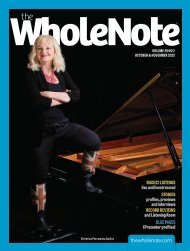Volume 23 Issue 3 - November 2017
In this issue: conversations (of one kind or another) galore! Daniela Nardi on taking the reins at "best-kept secret" venue, 918 Bathurst; composer Jeff Ryan on his "Afghanistan" Requiem for a Generation" partnership with war poet, Susan Steele; lutenist Ben Stein on seventeenth century jazz; collaborative pianist Philip Chiu on going solo; Barbara Hannigan on her upcoming Viennese "Second School" recital at Koerner; Tina Pearson on Pauline Oliveros; and as always a whole lot more!
In this issue: conversations (of one kind or another) galore! Daniela Nardi on taking the reins at "best-kept secret" venue, 918 Bathurst; composer Jeff Ryan on his "Afghanistan" Requiem for a Generation" partnership with war poet, Susan Steele; lutenist Ben Stein on seventeenth century jazz; collaborative pianist Philip Chiu on going solo; Barbara Hannigan on her upcoming Viennese "Second School" recital at Koerner; Tina Pearson on Pauline Oliveros; and as always a whole lot more!
Create successful ePaper yourself
Turn your PDF publications into a flip-book with our unique Google optimized e-Paper software.
Beat by Beat | Bandstand<br />
Quartetto Gelato<br />
Musicianship<br />
On Show<br />
JACK MACQUARRIE<br />
What a way to kick off the fall music season. Although I<br />
had often heard of Quartetto Gelato since they first hit<br />
the Toronto music scene 25 years ago, I had never had the<br />
opportunity to hear them in person. Now, here they were almost<br />
on my doorstep, at the classic Uxbridge Music Hall, 15 minutes<br />
from home. If you have not heard of Quartetto Gelato, you have<br />
been missing out on<br />
first-rate entertainment<br />
provided by a very skilled,<br />
classically trained ensemble<br />
with the most unusual<br />
instrumentation of violin,<br />
oboe, accordion and cello.<br />
The group has had numerous<br />
personnel changes since 1992<br />
with violinist and tenor singer<br />
Peter De Sotto being the only<br />
original member still in the<br />
group. Alexander Sevastian,<br />
who joined in 2002, was<br />
the winner of the renowned<br />
Coupe Mondiale International<br />
Accordion Competition in<br />
Washington in 2007. In 2009<br />
JACK MACQUARRIE<br />
they were joined by Colin<br />
Maier on a wide range of<br />
instruments including oboe,<br />
clarinet, violin, five-string<br />
banjo, electric/acoustic bass, flute, guitar and musical saw. In that year<br />
Elizabeth McLellan also joined the group on cello.<br />
With the unique sounds of this instrumentation, and their years<br />
of classical training, the ensemble boasts an eclectic repertoire that<br />
ranges from Brahms, Bach and Weber to Argentinian tangos, gypsy<br />
music and much more. Initially, from my vantage point in the balcony,<br />
I assumed that the accordion was the fairly well-known large piano<br />
accordion. After watching the dazzling movement of the fingers of<br />
Sevastian’s right hand, I realized that this was not the instrument that<br />
I had assumed. It is a rare Bayan accordion where the right hand has<br />
an amazing array of buttons. (For those who might be curious about<br />
the Bayan accordion there is a 30-minute lecture on YouTube detailing<br />
its complexities.)<br />
There was not a scrap of music in sight the entire evening. All of<br />
the shows musical and choreographic intricacies were performed<br />
by memory, with De Sotto switching routinely from violin to his<br />
fine tenor voice. Other than the cellist, who remained on her private<br />
podium, the others were often in movement. At one point, with De<br />
Sotto playing his violin while kneeling on centre stage, Maier put<br />
down his oboe, removed his shoes and socks and began a gymnastic<br />
routine flip-flopping back and forth over the violinist. It turns out that<br />
he is also a dancer and acrobat who spent a time in his career with<br />
Cirque du Soleil.<br />
How does this musical group get away with such histrionic showmanship,<br />
and what does this all have to do with this column? The<br />
answer: first and foremost, is that, for community bands there is<br />
a lesson to be learned here. Quartetto Gelato displays outstanding<br />
musicianship. With the music under complete control, then a musical<br />
group can afford to indulge in showmanship. Unfortunately, in many<br />
community bands, either showmanship takes precedence or remains<br />
completely hidden. Either way, the end result can be a lacklustre show.<br />
Musicianship<br />
What’s the best way for a community band or orchestra to achieve<br />
their musicianship goals? I’m sure there are many ways, but we just<br />
heard of an interesting procedure used by Ric Giorgi, conductor of the<br />
Strings Attached Orchestra. Here’s the kind of email message he sends<br />
to members of his group after a rehearsal: “1. Keep working to make<br />
a difference in the sound of notes according to the staccatos, tenutos,<br />
caps or accents etc they have over or under them. The rhythm was<br />
starting to sound pretty classy once you started playing these. Check<br />
your accidentals and see how far into the section after letter E you can<br />
get. 2. After letter E the arranger throws the melody around in bits to<br />
different sections, so write in (in pencil) the beat numbers and subbeat<br />
‘and’s with vertical lines over them so it’s clear how much you<br />
have to rest between notes as well as how you play when you have<br />
notes. Remember that an accidental affects every note in a bar after<br />
the accidental and any note<br />
that’s tied into the next bar.”<br />
This may all sound very<br />
elementary, but it certainly<br />
doesn’t hurt to honour<br />
the basics.<br />
While on the subject of<br />
Strings Attached, we just<br />
received word of their Young<br />
Composers Initiative (YCI).<br />
In <strong>November</strong> they will be<br />
performing Cassiopeia<br />
with the 2016 YCI winner<br />
in Orangeville. Last year’s<br />
second-place winner (now<br />
12 years old) has said that<br />
he’s determined to outdo<br />
his previous effort. More<br />
power to him.<br />
Henry Meredith with part of his collection.<br />
A trip to London<br />
Next recent musical journey<br />
for me was a trip to London, Ontario. The first part of this trip was<br />
to sit in as an observer of a class reunion of music graduates from<br />
Western University. While I did not attend this university, it was interesting<br />
to observe class mates of years gone by. Having not seen each<br />
other for years, they soon coalesced into a band and a choir in the<br />
morning and performed on stage in the afternoon. Again: musicianship<br />
at play.<br />
The other part of my journey took me to the home of Professor<br />
Henry Meredith, also known as Dr. Hank, the conductor of the noted<br />
Plumbing Factory Brass Band. Having donated some of my older<br />
instruments to his collection of old brass instruments, I was expecting<br />
to see a large array of instruments including some obscure vintage<br />
items rarely seen in public these days. Astounding would be a better to<br />
describe what I saw. On the ground floor of his house there were a few<br />
instruments. Then, in the basement I saw rows of trumpets, cornets<br />
and bugles hanging six deep on pegs in one section, with larger<br />
instruments in nearby nooks. Then it was off to the two-car garage.<br />
There were two cars in the driveway, but no room for them in the<br />
garage. Hanging all over were framed pictures of town and military<br />
bands from years gone by. How many forms of tubas, sousaphones,<br />
ophicleides and other bass instruments could there be? Then we went<br />
up to the loft over the garage. More varieties of instruments, row on<br />
row, greeted us.<br />
More about all this later, but, in short: I’d say all that Dr. Hank<br />
wants for Christmas is a museum to display his collection of 6.000-<br />
plus musical instruments.<br />
36 | <strong>November</strong> <strong>2017</strong> thewholenote.com


















